Tourism Sustainability: Enhancing CSR for Sustainable Tourism in Uganda
VerifiedAdded on 2023/06/04
|9
|1990
|63
AI Summary
This paper takes a comprehensive approach to sustainability in tourism in Uganda and how sustainability can be improved through CSR. The study is done on an area in Uganda known as Ruhija this paper seeks to analyze how enhancing sustainability of projects can help the local economy.
Contribute Materials
Your contribution can guide someone’s learning journey. Share your
documents today.

Running head: TOURISM SUSTAINABILITY
Tourism Sustainability
Name:
Institution:
Date:
Tourism Sustainability
Name:
Institution:
Date:
Secure Best Marks with AI Grader
Need help grading? Try our AI Grader for instant feedback on your assignments.
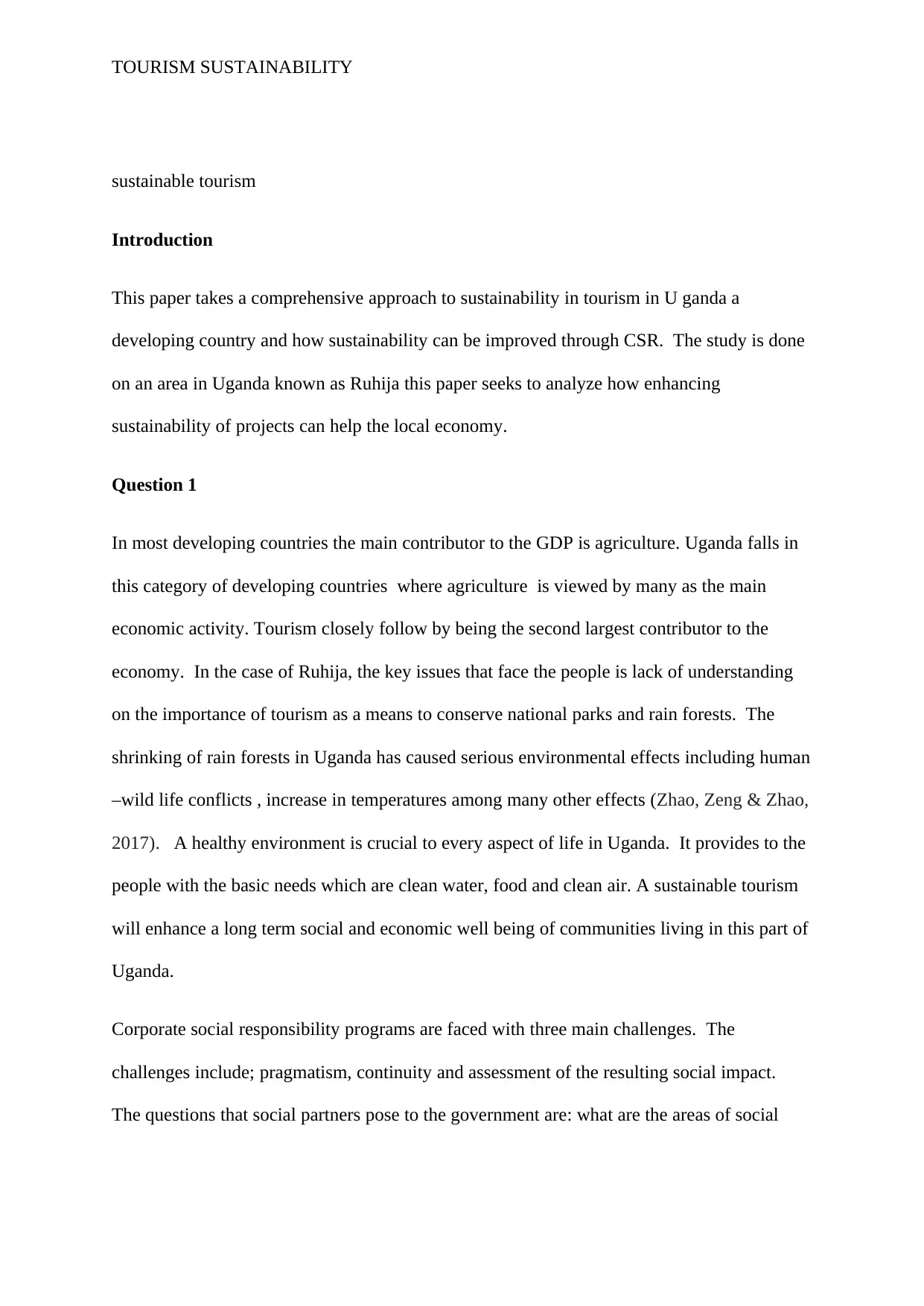
TOURISM SUSTAINABILITY
sustainable tourism
Introduction
This paper takes a comprehensive approach to sustainability in tourism in U ganda a
developing country and how sustainability can be improved through CSR. The study is done
on an area in Uganda known as Ruhija this paper seeks to analyze how enhancing
sustainability of projects can help the local economy.
Question 1
In most developing countries the main contributor to the GDP is agriculture. Uganda falls in
this category of developing countries where agriculture is viewed by many as the main
economic activity. Tourism closely follow by being the second largest contributor to the
economy. In the case of Ruhija, the key issues that face the people is lack of understanding
on the importance of tourism as a means to conserve national parks and rain forests. The
shrinking of rain forests in Uganda has caused serious environmental effects including human
–wild life conflicts , increase in temperatures among many other effects (Zhao, Zeng & Zhao,
2017). A healthy environment is crucial to every aspect of life in Uganda. It provides to the
people with the basic needs which are clean water, food and clean air. A sustainable tourism
will enhance a long term social and economic well being of communities living in this part of
Uganda.
Corporate social responsibility programs are faced with three main challenges. The
challenges include; pragmatism, continuity and assessment of the resulting social impact.
The questions that social partners pose to the government are: what are the areas of social
sustainable tourism
Introduction
This paper takes a comprehensive approach to sustainability in tourism in U ganda a
developing country and how sustainability can be improved through CSR. The study is done
on an area in Uganda known as Ruhija this paper seeks to analyze how enhancing
sustainability of projects can help the local economy.
Question 1
In most developing countries the main contributor to the GDP is agriculture. Uganda falls in
this category of developing countries where agriculture is viewed by many as the main
economic activity. Tourism closely follow by being the second largest contributor to the
economy. In the case of Ruhija, the key issues that face the people is lack of understanding
on the importance of tourism as a means to conserve national parks and rain forests. The
shrinking of rain forests in Uganda has caused serious environmental effects including human
–wild life conflicts , increase in temperatures among many other effects (Zhao, Zeng & Zhao,
2017). A healthy environment is crucial to every aspect of life in Uganda. It provides to the
people with the basic needs which are clean water, food and clean air. A sustainable tourism
will enhance a long term social and economic well being of communities living in this part of
Uganda.
Corporate social responsibility programs are faced with three main challenges. The
challenges include; pragmatism, continuity and assessment of the resulting social impact.
The questions that social partners pose to the government are: what are the areas of social
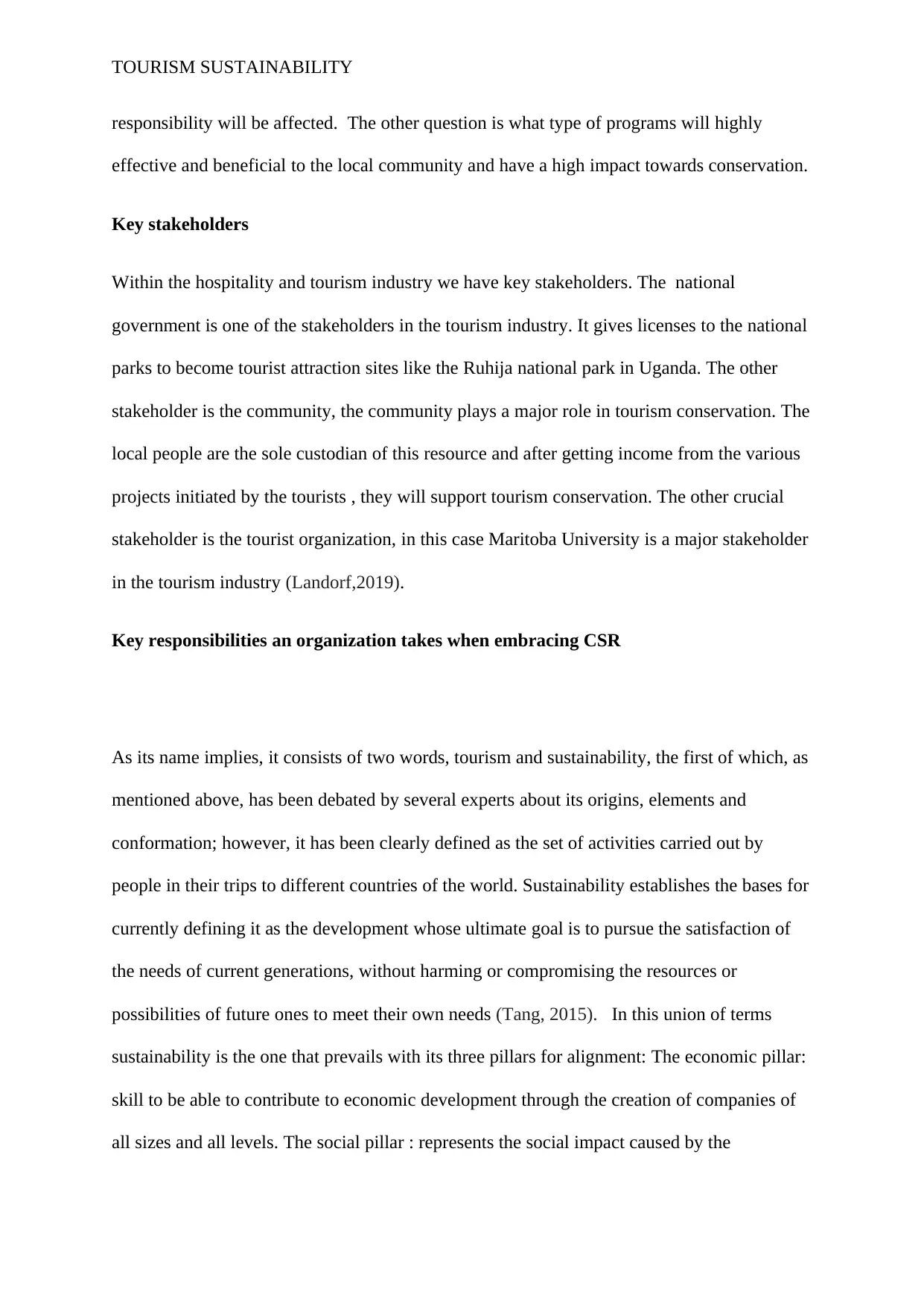
TOURISM SUSTAINABILITY
responsibility will be affected. The other question is what type of programs will highly
effective and beneficial to the local community and have a high impact towards conservation.
Key stakeholders
Within the hospitality and tourism industry we have key stakeholders. The national
government is one of the stakeholders in the tourism industry. It gives licenses to the national
parks to become tourist attraction sites like the Ruhija national park in Uganda. The other
stakeholder is the community, the community plays a major role in tourism conservation. The
local people are the sole custodian of this resource and after getting income from the various
projects initiated by the tourists , they will support tourism conservation. The other crucial
stakeholder is the tourist organization, in this case Maritoba University is a major stakeholder
in the tourism industry (Landorf,2019).
Key responsibilities an organization takes when embracing CSR
As its name implies, it consists of two words, tourism and sustainability, the first of which, as
mentioned above, has been debated by several experts about its origins, elements and
conformation; however, it has been clearly defined as the set of activities carried out by
people in their trips to different countries of the world. Sustainability establishes the bases for
currently defining it as the development whose ultimate goal is to pursue the satisfaction of
the needs of current generations, without harming or compromising the resources or
possibilities of future ones to meet their own needs (Tang, 2015). In this union of terms
sustainability is the one that prevails with its three pillars for alignment: The economic pillar:
skill to be able to contribute to economic development through the creation of companies of
all sizes and all levels. The social pillar : represents the social impact caused by the
responsibility will be affected. The other question is what type of programs will highly
effective and beneficial to the local community and have a high impact towards conservation.
Key stakeholders
Within the hospitality and tourism industry we have key stakeholders. The national
government is one of the stakeholders in the tourism industry. It gives licenses to the national
parks to become tourist attraction sites like the Ruhija national park in Uganda. The other
stakeholder is the community, the community plays a major role in tourism conservation. The
local people are the sole custodian of this resource and after getting income from the various
projects initiated by the tourists , they will support tourism conservation. The other crucial
stakeholder is the tourist organization, in this case Maritoba University is a major stakeholder
in the tourism industry (Landorf,2019).
Key responsibilities an organization takes when embracing CSR
As its name implies, it consists of two words, tourism and sustainability, the first of which, as
mentioned above, has been debated by several experts about its origins, elements and
conformation; however, it has been clearly defined as the set of activities carried out by
people in their trips to different countries of the world. Sustainability establishes the bases for
currently defining it as the development whose ultimate goal is to pursue the satisfaction of
the needs of current generations, without harming or compromising the resources or
possibilities of future ones to meet their own needs (Tang, 2015). In this union of terms
sustainability is the one that prevails with its three pillars for alignment: The economic pillar:
skill to be able to contribute to economic development through the creation of companies of
all sizes and all levels. The social pillar : represents the social impact caused by the
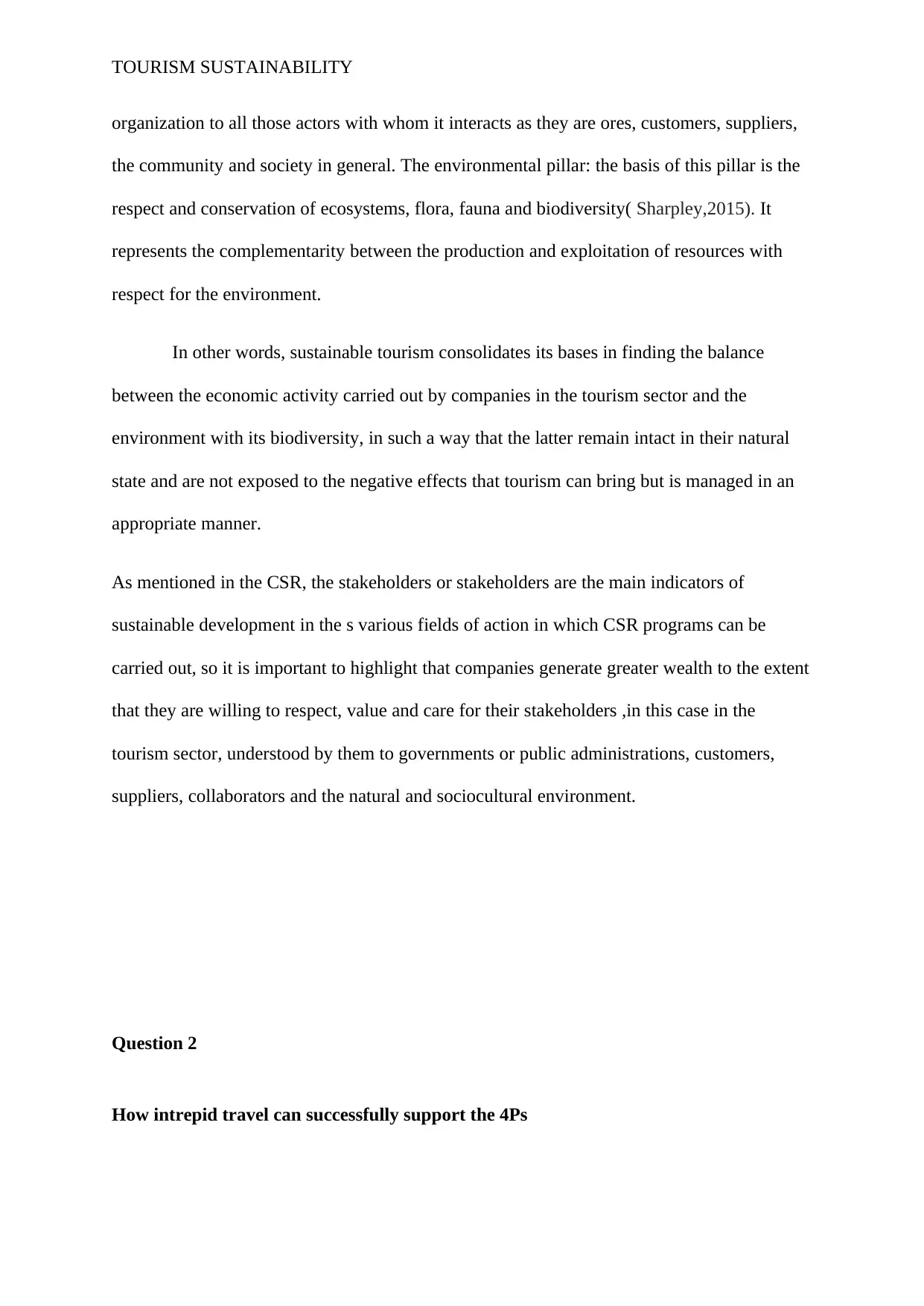
TOURISM SUSTAINABILITY
organization to all those actors with whom it interacts as they are ores, customers, suppliers,
the community and society in general. The environmental pillar: the basis of this pillar is the
respect and conservation of ecosystems, flora, fauna and biodiversity( Sharpley,2015). It
represents the complementarity between the production and exploitation of resources with
respect for the environment.
In other words, sustainable tourism consolidates its bases in finding the balance
between the economic activity carried out by companies in the tourism sector and the
environment with its biodiversity, in such a way that the latter remain intact in their natural
state and are not exposed to the negative effects that tourism can bring but is managed in an
appropriate manner.
As mentioned in the CSR, the stakeholders or stakeholders are the main indicators of
sustainable development in the s various fields of action in which CSR programs can be
carried out, so it is important to highlight that companies generate greater wealth to the extent
that they are willing to respect, value and care for their stakeholders ,in this case in the
tourism sector, understood by them to governments or public administrations, customers,
suppliers, collaborators and the natural and sociocultural environment.
Question 2
How intrepid travel can successfully support the 4Ps
organization to all those actors with whom it interacts as they are ores, customers, suppliers,
the community and society in general. The environmental pillar: the basis of this pillar is the
respect and conservation of ecosystems, flora, fauna and biodiversity( Sharpley,2015). It
represents the complementarity between the production and exploitation of resources with
respect for the environment.
In other words, sustainable tourism consolidates its bases in finding the balance
between the economic activity carried out by companies in the tourism sector and the
environment with its biodiversity, in such a way that the latter remain intact in their natural
state and are not exposed to the negative effects that tourism can bring but is managed in an
appropriate manner.
As mentioned in the CSR, the stakeholders or stakeholders are the main indicators of
sustainable development in the s various fields of action in which CSR programs can be
carried out, so it is important to highlight that companies generate greater wealth to the extent
that they are willing to respect, value and care for their stakeholders ,in this case in the
tourism sector, understood by them to governments or public administrations, customers,
suppliers, collaborators and the natural and sociocultural environment.
Question 2
How intrepid travel can successfully support the 4Ps
Secure Best Marks with AI Grader
Need help grading? Try our AI Grader for instant feedback on your assignments.

TOURISM SUSTAINABILITY
Economic progress is driven by entrepreneurial activities that are competitive and
consequently make profits. It is a primary responsibility of corporate governance to promote
an economic enterprise like intrepid. When entrepreneurs implement new combinations it
consequently lead to an extension of all aspects of a triple bottom line that is : for the people
the quality of life improves, it enhances competitive productivity that increases profit, it also
lead to sustainability of the resources in the planet for flourishing and survival of the
ecosystems and species (Chen,2015).
Intrepid travel provides competitive innovation and entrepreneurial initiatives as foundations
of sustainable prosperity. This enterprise progresses the lives of individuals and the
community in general. As a travel company, Intrepid is responsible for taking tourists to the
destinations and the money they spend has a direct impact to the lives of the people in Ruhija
community.
The quadruple bottomline of 4Ps – Profit, Planet , Progress and people provides the basis of a
framework that is comprehensive for developing measure of sustainable prosperity. As an
intermediary Intrepid travel has been involved in the following.
People-Quality of life
The quality of life for the people of Ruhija has improved- this is in two aspects i.e their
vigour, wellbeing because of the increased income and they continue to flourish.
Profit- competitive productivity
Economic progress is driven by entrepreneurial activities that are competitive and
consequently make profits. It is a primary responsibility of corporate governance to promote
an economic enterprise like intrepid. When entrepreneurs implement new combinations it
consequently lead to an extension of all aspects of a triple bottom line that is : for the people
the quality of life improves, it enhances competitive productivity that increases profit, it also
lead to sustainability of the resources in the planet for flourishing and survival of the
ecosystems and species (Chen,2015).
Intrepid travel provides competitive innovation and entrepreneurial initiatives as foundations
of sustainable prosperity. This enterprise progresses the lives of individuals and the
community in general. As a travel company, Intrepid is responsible for taking tourists to the
destinations and the money they spend has a direct impact to the lives of the people in Ruhija
community.
The quadruple bottomline of 4Ps – Profit, Planet , Progress and people provides the basis of a
framework that is comprehensive for developing measure of sustainable prosperity. As an
intermediary Intrepid travel has been involved in the following.
People-Quality of life
The quality of life for the people of Ruhija has improved- this is in two aspects i.e their
vigour, wellbeing because of the increased income and they continue to flourish.
Profit- competitive productivity

TOURISM SUSTAINABILITY
For the people in this community, competitive production of goods and services is key to
sustainability. The people of Ruhija have started engaging in activities that are likely to
increase profits with scarce resources.
Planet – Sustainable Ecosystems
Through sustainability programs initiated , the community and ecosystems survival across
generations and lifespans is guaranteed.
Progress – Adaptive Innovation
Change and adaptive learning for example building of housing camps that are more suitable
to tourists allows the people to have progress. Consumers want to know what the
environmental, social and economic impact of the products they buy is (Coccossis,2016). As
a result, those responsible companies that provide information about their actions will have a
better reputation in public opinion than those that hide the data. That is, corporate
responsibility will be rewarded with the confidence of consumers. This forecast is being
fulfilled more and more, but not at the desirable pace by the defenders of the sustainable
economy, nor in the same way in all countries.
Profit
Increase in profit and the market: increase in market share and turnover; increase in the
possibility of penetration in new markets; quality improvement; improvement of
competitiveness; improvement of relations with customers and the general public.
Better conditions of access to capital: greater attractiveness for investors, access to public
subsidies.
For the people in this community, competitive production of goods and services is key to
sustainability. The people of Ruhija have started engaging in activities that are likely to
increase profits with scarce resources.
Planet – Sustainable Ecosystems
Through sustainability programs initiated , the community and ecosystems survival across
generations and lifespans is guaranteed.
Progress – Adaptive Innovation
Change and adaptive learning for example building of housing camps that are more suitable
to tourists allows the people to have progress. Consumers want to know what the
environmental, social and economic impact of the products they buy is (Coccossis,2016). As
a result, those responsible companies that provide information about their actions will have a
better reputation in public opinion than those that hide the data. That is, corporate
responsibility will be rewarded with the confidence of consumers. This forecast is being
fulfilled more and more, but not at the desirable pace by the defenders of the sustainable
economy, nor in the same way in all countries.
Profit
Increase in profit and the market: increase in market share and turnover; increase in the
possibility of penetration in new markets; quality improvement; improvement of
competitiveness; improvement of relations with customers and the general public.
Better conditions of access to capital: greater attractiveness for investors, access to public
subsidies.
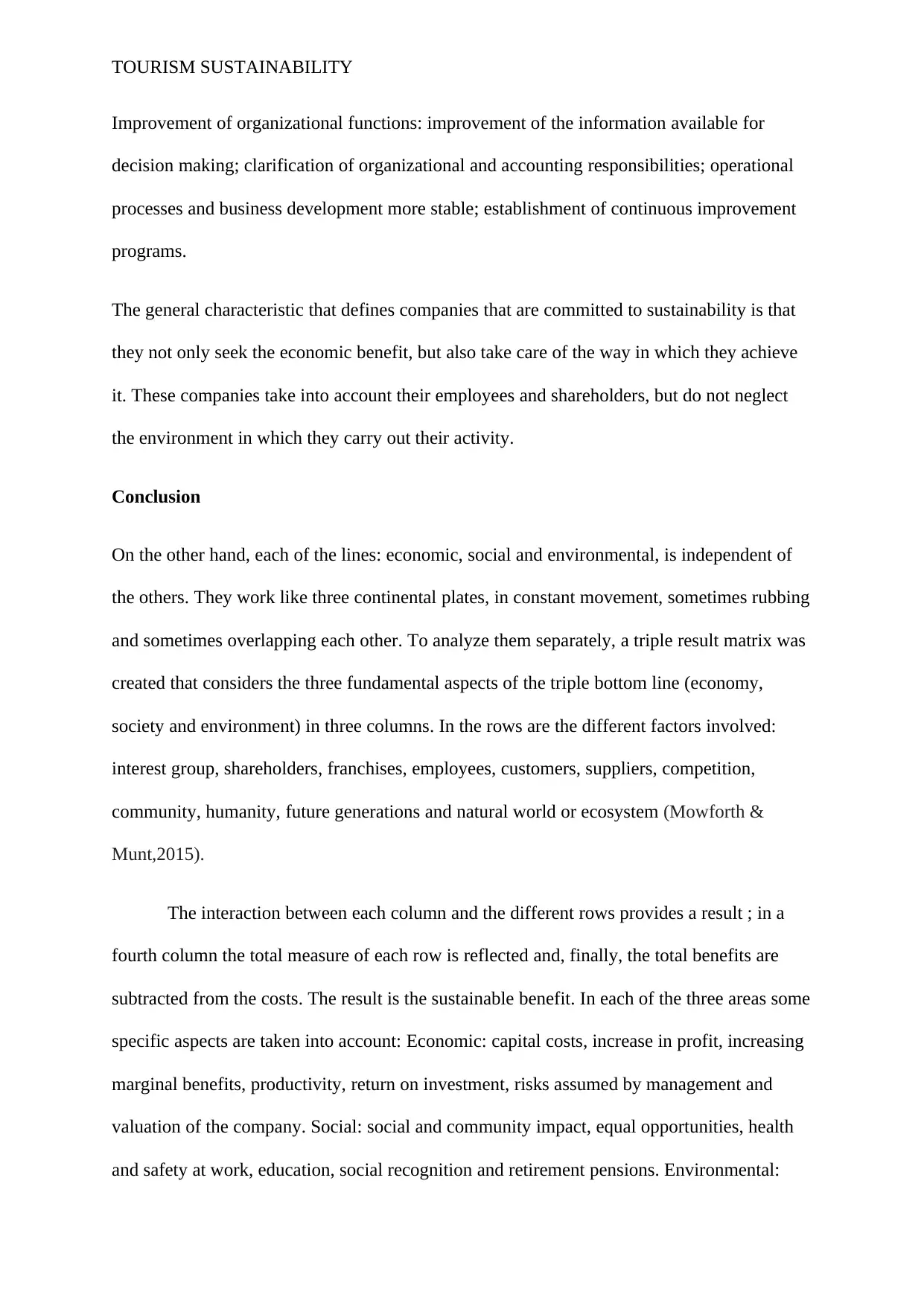
TOURISM SUSTAINABILITY
Improvement of organizational functions: improvement of the information available for
decision making; clarification of organizational and accounting responsibilities; operational
processes and business development more stable; establishment of continuous improvement
programs.
The general characteristic that defines companies that are committed to sustainability is that
they not only seek the economic benefit, but also take care of the way in which they achieve
it. These companies take into account their employees and shareholders, but do not neglect
the environment in which they carry out their activity.
Conclusion
On the other hand, each of the lines: economic, social and environmental, is independent of
the others. They work like three continental plates, in constant movement, sometimes rubbing
and sometimes overlapping each other. To analyze them separately, a triple result matrix was
created that considers the three fundamental aspects of the triple bottom line (economy,
society and environment) in three columns. In the rows are the different factors involved:
interest group, shareholders, franchises, employees, customers, suppliers, competition,
community, humanity, future generations and natural world or ecosystem (Mowforth &
Munt,2015).
The interaction between each column and the different rows provides a result ; in a
fourth column the total measure of each row is reflected and, finally, the total benefits are
subtracted from the costs. The result is the sustainable benefit. In each of the three areas some
specific aspects are taken into account: Economic: capital costs, increase in profit, increasing
marginal benefits, productivity, return on investment, risks assumed by management and
valuation of the company. Social: social and community impact, equal opportunities, health
and safety at work, education, social recognition and retirement pensions. Environmental:
Improvement of organizational functions: improvement of the information available for
decision making; clarification of organizational and accounting responsibilities; operational
processes and business development more stable; establishment of continuous improvement
programs.
The general characteristic that defines companies that are committed to sustainability is that
they not only seek the economic benefit, but also take care of the way in which they achieve
it. These companies take into account their employees and shareholders, but do not neglect
the environment in which they carry out their activity.
Conclusion
On the other hand, each of the lines: economic, social and environmental, is independent of
the others. They work like three continental plates, in constant movement, sometimes rubbing
and sometimes overlapping each other. To analyze them separately, a triple result matrix was
created that considers the three fundamental aspects of the triple bottom line (economy,
society and environment) in three columns. In the rows are the different factors involved:
interest group, shareholders, franchises, employees, customers, suppliers, competition,
community, humanity, future generations and natural world or ecosystem (Mowforth &
Munt,2015).
The interaction between each column and the different rows provides a result ; in a
fourth column the total measure of each row is reflected and, finally, the total benefits are
subtracted from the costs. The result is the sustainable benefit. In each of the three areas some
specific aspects are taken into account: Economic: capital costs, increase in profit, increasing
marginal benefits, productivity, return on investment, risks assumed by management and
valuation of the company. Social: social and community impact, equal opportunities, health
and safety at work, education, social recognition and retirement pensions. Environmental:
Paraphrase This Document
Need a fresh take? Get an instant paraphrase of this document with our AI Paraphraser
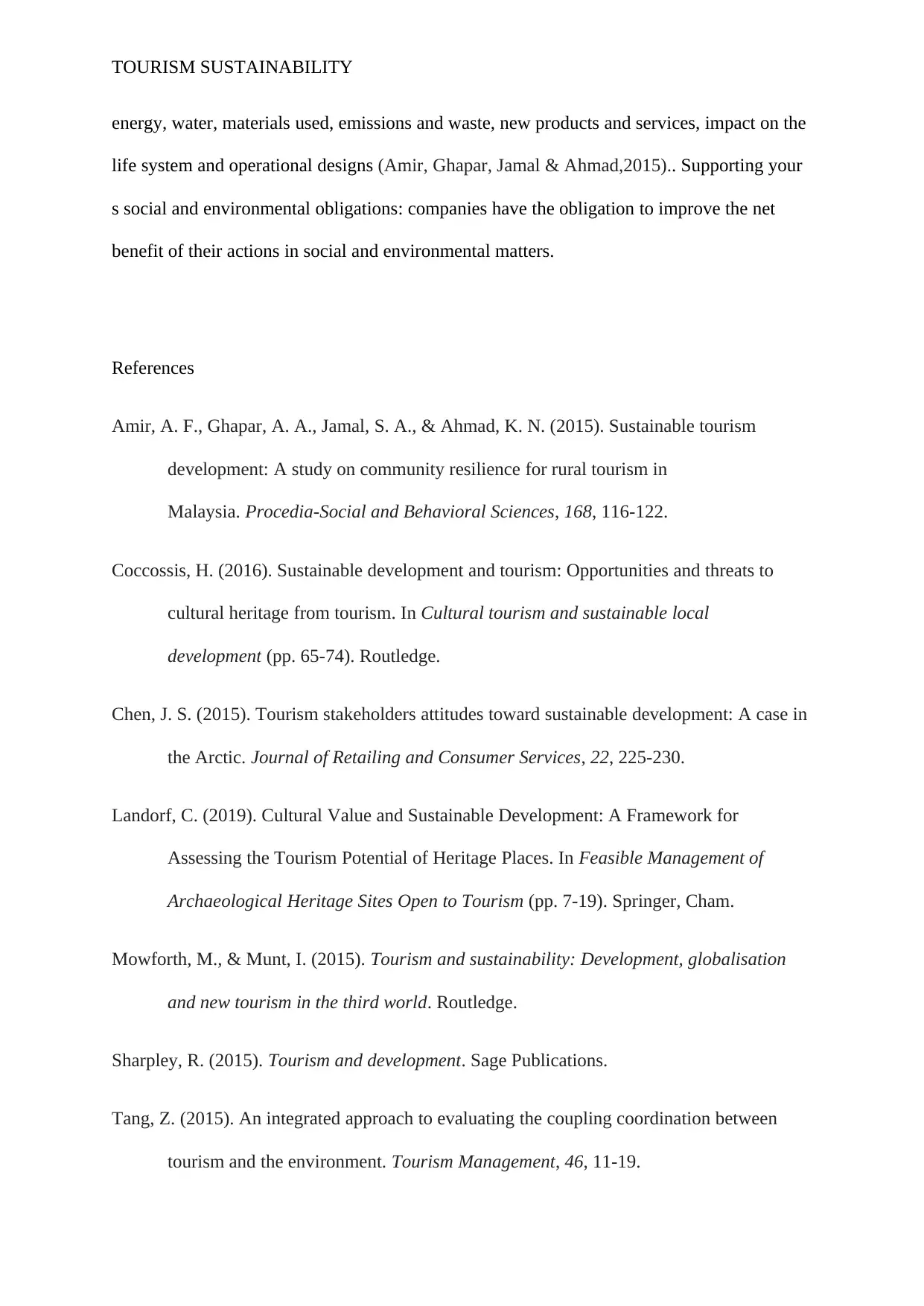
TOURISM SUSTAINABILITY
energy, water, materials used, emissions and waste, new products and services, impact on the
life system and operational designs (Amir, Ghapar, Jamal & Ahmad,2015).. Supporting your
s social and environmental obligations: companies have the obligation to improve the net
benefit of their actions in social and environmental matters.
References
Amir, A. F., Ghapar, A. A., Jamal, S. A., & Ahmad, K. N. (2015). Sustainable tourism
development: A study on community resilience for rural tourism in
Malaysia. Procedia-Social and Behavioral Sciences, 168, 116-122.
Coccossis, H. (2016). Sustainable development and tourism: Opportunities and threats to
cultural heritage from tourism. In Cultural tourism and sustainable local
development (pp. 65-74). Routledge.
Chen, J. S. (2015). Tourism stakeholders attitudes toward sustainable development: A case in
the Arctic. Journal of Retailing and Consumer Services, 22, 225-230.
Landorf, C. (2019). Cultural Value and Sustainable Development: A Framework for
Assessing the Tourism Potential of Heritage Places. In Feasible Management of
Archaeological Heritage Sites Open to Tourism (pp. 7-19). Springer, Cham.
Mowforth, M., & Munt, I. (2015). Tourism and sustainability: Development, globalisation
and new tourism in the third world. Routledge.
Sharpley, R. (2015). Tourism and development. Sage Publications.
Tang, Z. (2015). An integrated approach to evaluating the coupling coordination between
tourism and the environment. Tourism Management, 46, 11-19.
energy, water, materials used, emissions and waste, new products and services, impact on the
life system and operational designs (Amir, Ghapar, Jamal & Ahmad,2015).. Supporting your
s social and environmental obligations: companies have the obligation to improve the net
benefit of their actions in social and environmental matters.
References
Amir, A. F., Ghapar, A. A., Jamal, S. A., & Ahmad, K. N. (2015). Sustainable tourism
development: A study on community resilience for rural tourism in
Malaysia. Procedia-Social and Behavioral Sciences, 168, 116-122.
Coccossis, H. (2016). Sustainable development and tourism: Opportunities and threats to
cultural heritage from tourism. In Cultural tourism and sustainable local
development (pp. 65-74). Routledge.
Chen, J. S. (2015). Tourism stakeholders attitudes toward sustainable development: A case in
the Arctic. Journal of Retailing and Consumer Services, 22, 225-230.
Landorf, C. (2019). Cultural Value and Sustainable Development: A Framework for
Assessing the Tourism Potential of Heritage Places. In Feasible Management of
Archaeological Heritage Sites Open to Tourism (pp. 7-19). Springer, Cham.
Mowforth, M., & Munt, I. (2015). Tourism and sustainability: Development, globalisation
and new tourism in the third world. Routledge.
Sharpley, R. (2015). Tourism and development. Sage Publications.
Tang, Z. (2015). An integrated approach to evaluating the coupling coordination between
tourism and the environment. Tourism Management, 46, 11-19.

TOURISM SUSTAINABILITY
Zhao, R. X., Zeng, J. Q., & Zhao, J. L. (2017). Analysis of Provincial Tourism Sustainable
Development Model and Countermeasure. Eurasia Journal of Mathematics, Science
and Technology Education, 13(12), 7671-7677.
Zhao, R. X., Zeng, J. Q., & Zhao, J. L. (2017). Analysis of Provincial Tourism Sustainable
Development Model and Countermeasure. Eurasia Journal of Mathematics, Science
and Technology Education, 13(12), 7671-7677.
1 out of 9
Related Documents
Your All-in-One AI-Powered Toolkit for Academic Success.
+13062052269
info@desklib.com
Available 24*7 on WhatsApp / Email
![[object Object]](/_next/static/media/star-bottom.7253800d.svg)
Unlock your academic potential
© 2024 | Zucol Services PVT LTD | All rights reserved.



